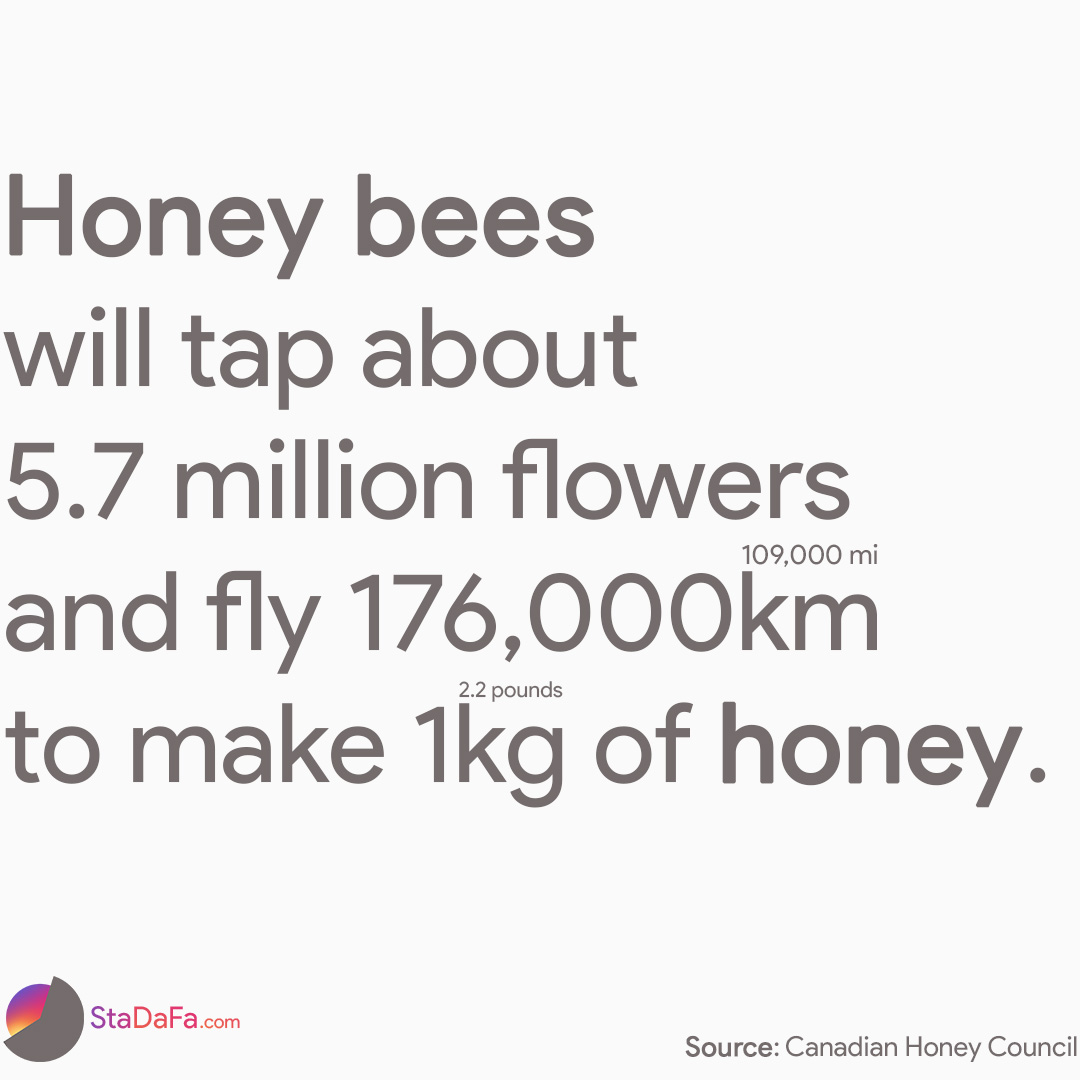What it takes to make a kg of honey
Honey bees will tap about 5.7 million flowers and fly 176,000km to make one kg of honey.
According to the Canadian Honey Council
Calculation of honey production by one honey bee
Many facts are taken for granted and the proof is often lost in the mists of time. It may seem hard to believe that a honey bee flies around the world twice for one pound of honey but the numbers back up this assertion. The valuesused for the calculation are averages and the numbers are rounded. To discover how many flowers and how far a honey bee flies to gather a pound of honey, we need to know:
How many flowers a bee visits to gather one load of nectar? C.R. Ribbands (1949) determined that one bee can visit several hundred flowers for a load of sweet clover and up to 1,110-1,446 for a load of Limnanthes nectar. Since the number will vary by size of the flower and quantity of nectar secreted, we will assume a honey bee taps fewer flowers than she visits and we have used a minimum of 100 flowers for our calculation.
How much nectar she collects in one load?
Park (1922, 1925) found that the weight of nectar per load was an average was 40 mg during the nectar flow and Lundie (1925) found an average of 25 mg. We can assume a median value of 32 mg nectar per load.
What percentage of the nectar collected is converted to honey?
Wilson et al. (1958) lists the sugar content of clover and alfalfa (our most common honey crop ) as 45% sugar concentration. The water content has to be evaporated until the sugar concentration is over 80% and water less than 20% to make honey. Using an average value of 45% sugar concentration in a 32 mg nectar load there are 14 mg invert sugars and 2.8 mg water used in making 17 mg honey.
The distance of an average foraging trip?
The distance of the foraging trip varies according to the location of the nectar source and the quantity of nectar secreted. Martin (1970) found that bees like to forage 4 km (2.5 miles) from the hive ranging over 12,500 acres. Others have found that the median radius of a colony is a few hundred meters in agricultural areas and 2 km in forested regions (2- 4 km return trip). Using a median value of 3 km for a nectar collection trip we can find the distance flown to collect honey.
Calculation:
Distance flown to collect one pound of honey
3 km = 17 mg honey
3,000 km = 17 g honey
80,117 km = 454 g honey
50,000 miles per pound of honey (80,000 Km per pound)
176,000 km per kilo of honey
Number of flowers visited to make one pound of honey
100 flowers= 17 mg honey
100,000 flowers= 17 g honey
2,670,588 flowers = 454 g honey
over 2.6 million flowers visited for one pound of honey
over 5.7 million flowers visited for one kilo of honey
Diameter of earth = 12,714 km
Circumference = pi * 12,714 km = 39,942 km (25K miles)
Distance flown by a bee to collect one pound of honey = 2 circumferences of earth
References
Lundie, A.E. (1925) The flight activities of the honeybee. USDA Bull.1328
Martin, E. (1970) Bee pollination ecology. Michigan State University E. Lansing MI
Park, O.W. (1925) The minimum flying weight of the honeybee. Iowa State Apiarist Report pp83-90.
Park, O.W. (1929) Time factors in relation to the acquisition of food by the honeybee. Iowa Agric. Exp. Sta. Res. Bull. 108.
Ribbands, C.R. (1949)The foraging method of individual honey bees. J. Anim Ecol 18:47-66.
Wilson W.T.,J.O. Moffatt, J.D. Hamilton, (1958) Nectar and pollen plants of Colorado. Bull.503-505 Colo.Expl.Sta.,Fort Collins,Ore. 71pp.


Comments
Post a Comment